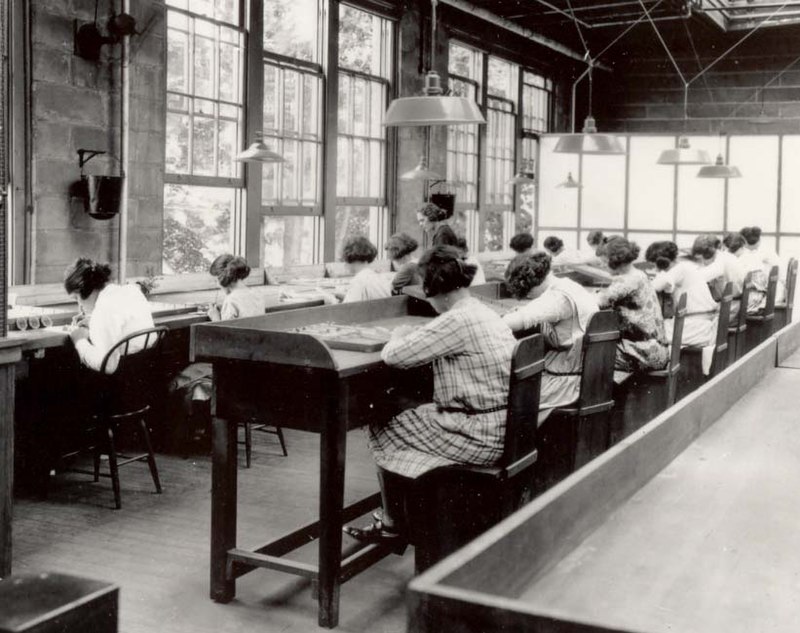The discovery of radium in 1898 by Marie Curie was followed by a craze for all things radium as people rushed to find commercial applications for this new and exciting element. During the 1910s, glow in the dark products took the public by storm, with glowing clocks and watch dials becoming extremely popular.
A Glowing Opportunity
With the onset of the First World War, many women took up work in factories. Radium factories were seen as a particularly glamorous option, as the glowing paint was fun to work with and the positions were very well paid. After the US entered the war in 1917, the military entered into a contract with the Radium Luminous Materials Corporation to produce glowing watches for their soldiers. This caused a new influx of staff at the radium factories, who consisted of mostly teenagers and young women, as their hands were smaller and therefore better suited to the minute detail needed to paint the watch dials. However, what at first seemed to be a great opportunity soon turned out to be deadly.
Dangerous Disinformation
Even though the danger of radium poisoning was well known by the factory managers, the women employed to work with the glowing paint were not informed about it. In fact, they were deliberately misled to believe that the paint they were using was completely safe. Each painter applied the radium paint using a small camel hair brush, which had to be re-pointed every few strokes. To keep the brush tips sharp, management instructed the women to lick the brushes, causing them to ingest large quantities of the radioactive paint.

The first person to publicise that radium was making the dial painters sick was a dentist from New Jersey. In 1924, Dr Theodor Blum came across a patient suffering from constant bleeding and infection of the jawbone. Making the link between the condition and his patient’s occupation as a dial painter, he dubbed the new phenomenon ‘radium jaw’. The following year, Dr. Frederick L. Hoffman found several more dial painters who were suffering from the same symptoms. It is now understood that the body treats radium as a substitute for calcium, and absorbs it into the bones and teeth. As the years went on, more and more women who had worked as dial painters were becoming sick and dying from anemia and bone cancer caused by radium poisoning.
A Wall of Denial
Though study after study linked radium ingestion to the sickness the dial painters were suffering from, the companies tried a whole host of underhand tactics to silence the women and save the companies’ reputation. Doctors were encouraged to claim that the affected girls had died of syphilis in an attempt to discredit them. The company also claimed that they had hired ‘a great many people who were physically unfit to procure employment in other lines of industry.’ as an act of kindness. They insisted that the poisoned women had already been sick when they were hired, and that radium therefore couldn’t be to blame.
A Victory for Occupational Health
In 1928, five women were finally able to bring U.S Radium to court; Grace Fryer, Edna Hussman, Katherine Schaub, Quinta McDonald, and Albina Larice. The company had tried to delay the case as much as possible, as the women were all so sick that there was a good chance they would die before they reached trial.
News of the trial and the evidence both of the women’s suffering and the company’s underhand tactics caused a worldwide outrage. Realising that the jury would not find in their favour, U.S Radium settled the case, giving each woman $10,000 (around $150,000 today) plus another $600 a year. It was a miserly sum that did little to abate the suffering the women had endured. Even then, the company had the audacity to appeal against findings against them in other cases across the country, eventually going all the way to the Supreme Court in 1938. Fortunately, the Supreme Court refused to hear their case and the company was forced to accept liability for all the lives they had ruined.
Some lasting good did come of the case, however. As a result of the case, the right for workers to sue companies for damages was established, and the case set several important legal precedents that gave much greater protection for workers in the US. This included extending the statute of limitations, giving workers longer than the two years they had been allowed previously to find and report illnesses caused by their work. In 1941, the state of New Jersey passed a law making all industrial diseases eligible for compensation, and included radium necrosis as a recognised occupational disease.
Sources and Further Reading
https://s3.wp.wsu.edu/uploads/sites/1058/2016/09/Rowland-1994.pdf
Moore, K., The Radium Girls, (2016)